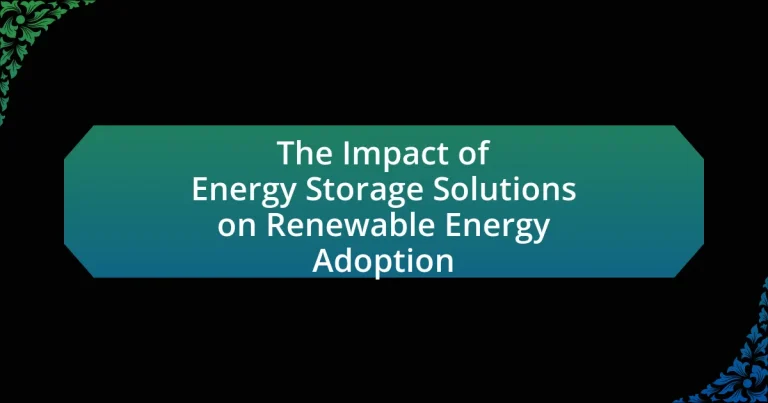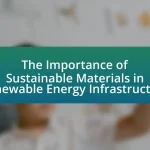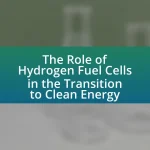Energy storage solutions are critical technologies that capture and store energy for later use, significantly enhancing the adoption of renewable energy sources such as solar and wind. These solutions, which include batteries, pumped hydro storage, and thermal storage, address the intermittent nature of renewables by balancing energy supply and demand, thereby improving grid stability and reliability. The article explores the various technologies involved in energy storage, their environmental impacts, economic implications, and the role of government policies in promoting their adoption. Additionally, it discusses future trends, market growth predictions, and best practices for integrating energy storage into renewable energy strategies, highlighting the importance of these solutions in achieving a sustainable energy future.
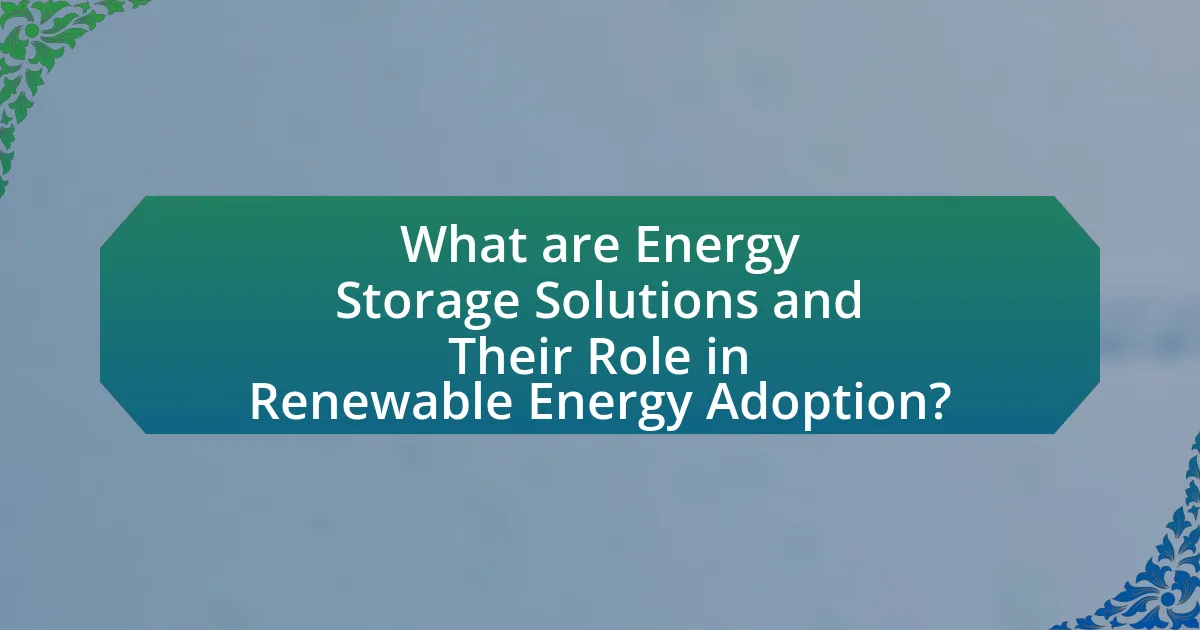
What are Energy Storage Solutions and Their Role in Renewable Energy Adoption?
Energy storage solutions are technologies that capture and store energy for later use, playing a crucial role in the adoption of renewable energy sources like solar and wind. These solutions, including batteries, pumped hydro storage, and thermal storage, enable the management of energy supply and demand by storing excess energy generated during peak production times and releasing it during periods of low generation or high demand. For instance, according to the International Renewable Energy Agency (IRENA), energy storage can enhance grid stability and reliability, facilitating a higher penetration of renewables into the energy mix. This capability is essential for addressing the intermittent nature of renewable energy sources, thereby accelerating their integration into the energy system and supporting a transition to a more sustainable energy future.
How do Energy Storage Solutions function in the context of renewable energy?
Energy storage solutions function by capturing and storing energy generated from renewable sources, such as solar and wind, for later use. These systems, including batteries and pumped hydro storage, enable the balancing of supply and demand, ensuring that energy is available even when generation is low. For instance, during peak sunlight hours, solar panels can produce excess energy, which can be stored in batteries and utilized during nighttime or cloudy periods. This capability enhances grid stability and reliability, facilitating a higher penetration of renewable energy into the energy mix. According to the International Renewable Energy Agency (IRENA), energy storage can increase the share of renewables in the global energy system, making it a critical component for achieving energy transition goals.
What technologies are involved in Energy Storage Solutions?
Energy storage solutions involve several key technologies, including lithium-ion batteries, flow batteries, pumped hydro storage, compressed air energy storage, and thermal energy storage. Lithium-ion batteries are widely used due to their high energy density and efficiency, accounting for over 90% of the global battery market in 2020. Flow batteries, such as vanadium redox batteries, offer scalability and long-duration storage capabilities, making them suitable for renewable energy applications. Pumped hydro storage, the most established technology, utilizes gravitational potential energy to store and release electricity, representing about 95% of global energy storage capacity. Compressed air energy storage stores energy in the form of compressed air in underground caverns, while thermal energy storage systems, like molten salt, store heat for later use in power generation. These technologies collectively enhance the reliability and integration of renewable energy sources into the grid.
How do these technologies enhance renewable energy systems?
Energy storage technologies enhance renewable energy systems by enabling the efficient capture and utilization of energy generated from intermittent sources like solar and wind. These technologies, such as batteries and pumped hydro storage, allow for the storage of excess energy produced during peak generation times, which can then be released during periods of low generation or high demand. For instance, according to the International Renewable Energy Agency (IRENA), energy storage can increase the share of renewables in the energy mix by providing grid stability and reliability, thus facilitating a smoother integration of renewable sources into the energy system. This capability not only maximizes the use of renewable energy but also reduces reliance on fossil fuels, contributing to lower greenhouse gas emissions.
Why are Energy Storage Solutions critical for renewable energy integration?
Energy storage solutions are critical for renewable energy integration because they enable the balancing of supply and demand, ensuring a reliable energy supply despite the intermittent nature of renewable sources like solar and wind. These solutions store excess energy generated during peak production times and release it during periods of low generation, thus stabilizing the grid. For instance, according to the International Renewable Energy Agency, energy storage can increase the share of renewables in the energy mix by up to 30% by 2030, demonstrating its essential role in facilitating higher renewable energy adoption.
What challenges do renewable energy sources face without storage solutions?
Renewable energy sources face significant challenges without storage solutions, primarily due to their intermittent nature. For instance, solar and wind energy generation is dependent on weather conditions and time of day, leading to periods of excess generation followed by shortages. This inconsistency can result in grid instability, making it difficult to match supply with demand. According to the U.S. Department of Energy, without adequate storage, renewable energy can only provide about 20% of the grid’s energy needs reliably. Additionally, the lack of storage limits the ability to utilize generated energy during peak demand times, leading to wasted resources and reduced economic viability for renewable projects.
How do Energy Storage Solutions mitigate these challenges?
Energy storage solutions mitigate challenges associated with renewable energy adoption by providing a means to store excess energy generated during peak production times for use during periods of low generation. This capability addresses the intermittency of renewable sources like solar and wind, which can produce energy inconsistently due to weather conditions. For instance, according to the U.S. Department of Energy, energy storage can enhance grid reliability and stability, allowing for a smoother integration of renewable energy sources into the existing energy infrastructure. By balancing supply and demand, energy storage solutions reduce the risk of energy shortages and help maintain consistent energy availability, thereby facilitating a more robust transition to renewable energy systems.
What are the environmental impacts of Energy Storage Solutions?
Energy storage solutions have significant environmental impacts, both positive and negative. On the positive side, they enhance the integration of renewable energy sources, such as solar and wind, by storing excess energy generated during peak production times and releasing it during periods of high demand. This capability reduces reliance on fossil fuels, thereby decreasing greenhouse gas emissions. For instance, a study by the National Renewable Energy Laboratory found that energy storage can reduce carbon emissions by up to 30% in certain grid scenarios.
Conversely, the production and disposal of energy storage systems, particularly lithium-ion batteries, can lead to environmental concerns. The mining of lithium, cobalt, and nickel can result in habitat destruction, water pollution, and significant carbon emissions. Additionally, improper disposal of batteries can lead to soil and water contamination due to toxic materials. According to the International Energy Agency, the environmental impact of battery production is a critical consideration, as it can account for up to 50% of the lifecycle emissions of electric vehicles.
In summary, while energy storage solutions facilitate the transition to renewable energy and contribute to emission reductions, they also pose environmental challenges related to resource extraction and waste management.
How do Energy Storage Solutions contribute to reducing carbon emissions?
Energy storage solutions significantly contribute to reducing carbon emissions by enabling the effective integration of renewable energy sources into the power grid. These systems store excess energy generated from renewable sources, such as solar and wind, during periods of low demand and release it during peak demand times. This process minimizes reliance on fossil fuel-based power plants, which are major contributors to carbon emissions. For instance, a study by the National Renewable Energy Laboratory found that energy storage could reduce greenhouse gas emissions by up to 80% in certain scenarios by facilitating a higher penetration of renewables in the energy mix. Thus, energy storage solutions play a crucial role in transitioning to a low-carbon energy system.
What are the potential negative impacts of Energy Storage Solutions?
Energy storage solutions can have several potential negative impacts, including environmental concerns, economic challenges, and safety risks. The production and disposal of batteries, particularly lithium-ion batteries, can lead to significant environmental degradation due to mining activities and toxic waste generation. For instance, lithium extraction can result in water depletion and pollution in local ecosystems. Economically, the high initial costs of energy storage systems can deter investment and slow down the adoption of renewable energy technologies. Additionally, safety risks such as battery fires and chemical leaks pose threats to both human health and the environment, as evidenced by incidents involving battery failures in various applications. These factors collectively highlight the complexities and challenges associated with energy storage solutions in the context of renewable energy adoption.

What are the Economic Implications of Energy Storage Solutions?
Energy storage solutions have significant economic implications by enabling more efficient integration of renewable energy sources into the grid. These solutions reduce reliance on fossil fuels, leading to lower energy costs and increased energy security. For instance, a study by the International Renewable Energy Agency (IRENA) found that energy storage can reduce the levelized cost of electricity from renewables by up to 30% by 2030. Additionally, energy storage systems can provide ancillary services, such as frequency regulation and demand response, which can generate revenue streams for operators. The deployment of energy storage also stimulates job creation in manufacturing, installation, and maintenance sectors, contributing to economic growth.
How do Energy Storage Solutions affect the cost of renewable energy?
Energy storage solutions significantly reduce the cost of renewable energy by enabling more efficient energy management and increasing the reliability of supply. By storing excess energy generated during peak production times, such as sunny or windy periods, these solutions allow for energy to be used when demand is high, thus minimizing reliance on fossil fuels and reducing overall energy costs. According to a report by the International Renewable Energy Agency (IRENA), the cost of battery storage has fallen by 89% since 2010, which directly contributes to lowering the levelized cost of electricity (LCOE) for renewable sources. This decline in storage costs enhances the economic viability of renewables, making them more competitive with traditional energy sources.
What are the initial investment costs associated with Energy Storage Solutions?
The initial investment costs associated with Energy Storage Solutions typically range from $300 to $600 per kilowatt-hour for lithium-ion battery systems. These costs encompass the price of the battery units, installation, and necessary infrastructure. For instance, a 1 megawatt-hour lithium-ion battery system can cost between $300,000 and $600,000, depending on the specific technology and scale of deployment. This pricing reflects the significant capital required to implement energy storage systems, which is crucial for enhancing the reliability and efficiency of renewable energy sources.
How do Energy Storage Solutions influence long-term savings for consumers?
Energy storage solutions significantly influence long-term savings for consumers by enabling the efficient use of renewable energy. These systems allow consumers to store excess energy generated during peak production times, such as sunny or windy days, for use during periods of high demand or low production. This capability reduces reliance on grid electricity, which can be more expensive during peak hours.
For instance, a study by the National Renewable Energy Laboratory found that residential energy storage can lead to savings of up to 30% on electricity bills by optimizing energy usage and minimizing peak demand charges. Additionally, energy storage systems can provide backup power during outages, further enhancing their value and potential savings for consumers.
What role do government policies play in promoting Energy Storage Solutions?
Government policies play a crucial role in promoting Energy Storage Solutions by providing financial incentives, regulatory frameworks, and research funding. These policies encourage investment in energy storage technologies, which are essential for integrating renewable energy sources like solar and wind into the grid. For instance, the U.S. federal government has implemented tax credits and grants, such as the Investment Tax Credit (ITC), which has significantly boosted the deployment of energy storage systems. According to the U.S. Energy Storage Association, these policies have led to a 200% increase in energy storage capacity from 2015 to 2020, demonstrating their effectiveness in fostering market growth and innovation in energy storage solutions.
How do incentives and subsidies impact the adoption of Energy Storage Solutions?
Incentives and subsidies significantly enhance the adoption of Energy Storage Solutions by reducing the financial burden on consumers and businesses. These financial mechanisms lower the upfront costs associated with purchasing and installing energy storage systems, making them more accessible. For instance, a study by the International Renewable Energy Agency (IRENA) found that government incentives can reduce the payback period for energy storage investments by up to 30%, thereby encouraging more widespread implementation. Additionally, subsidies can stimulate market demand, leading to economies of scale that further decrease costs over time. This financial support is crucial in accelerating the transition to renewable energy sources, as it enables more users to integrate energy storage into their systems, ultimately facilitating greater renewable energy adoption.
What are the regulatory challenges facing Energy Storage Solutions?
Energy Storage Solutions face several regulatory challenges, primarily related to inconsistent policies, interconnection standards, and market participation rules. Inconsistent policies across different jurisdictions create uncertainty for investors and developers, hindering the deployment of energy storage technologies. Additionally, varying interconnection standards can complicate the integration of storage systems with existing energy infrastructure, leading to delays and increased costs. Furthermore, market participation rules often do not adequately recognize the value of energy storage in providing grid services, which can limit the economic viability of these solutions. For instance, the Federal Energy Regulatory Commission (FERC) Order 841 aims to address some of these issues by ensuring that energy storage resources can compete in wholesale markets, yet implementation varies by region, highlighting the ongoing regulatory challenges.
How do Energy Storage Solutions create job opportunities in the renewable sector?
Energy storage solutions create job opportunities in the renewable sector by facilitating the integration of renewable energy sources into the grid, which requires skilled labor for installation, maintenance, and operation. As the demand for renewable energy increases, energy storage technologies, such as batteries and pumped hydro storage, become essential for balancing supply and demand, leading to job creation in manufacturing, engineering, and project management. For instance, the U.S. Energy Storage Association reported that the energy storage sector employed over 30,000 workers in 2020, reflecting a significant growth trajectory driven by the expansion of renewable energy projects.
What types of jobs are generated by the development of Energy Storage Solutions?
The development of Energy Storage Solutions generates various types of jobs, including manufacturing, installation, maintenance, and research and development roles. Manufacturing jobs are created in the production of batteries and other storage technologies, with the global battery market projected to reach $100 billion by 2025, indicating significant job growth in this sector. Installation jobs arise as energy storage systems are integrated into renewable energy projects, requiring skilled technicians for setup and configuration. Maintenance roles are essential for ensuring the longevity and efficiency of these systems, leading to ongoing employment opportunities. Additionally, research and development positions are critical for advancing energy storage technologies, with investments in this area expected to drive innovation and create high-skilled jobs.
How does the growth of Energy Storage Solutions impact local economies?
The growth of Energy Storage Solutions positively impacts local economies by creating jobs, stimulating investment, and enhancing energy resilience. As energy storage technologies expand, they require skilled labor for manufacturing, installation, and maintenance, leading to job creation in various sectors. For instance, the U.S. energy storage market is projected to create over 100,000 jobs by 2030, according to the U.S. Department of Energy. Additionally, investments in energy storage infrastructure attract capital to local areas, fostering economic development and innovation. Furthermore, energy storage enhances grid reliability, reducing energy costs for consumers and businesses, which can lead to increased economic activity.
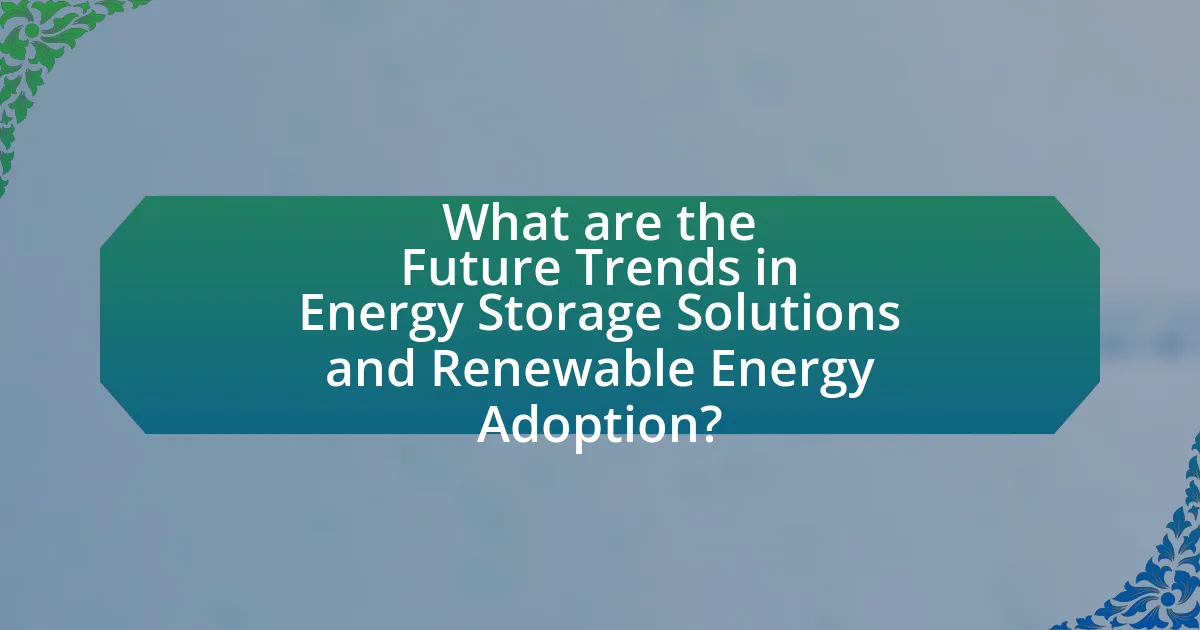
What are the Future Trends in Energy Storage Solutions and Renewable Energy Adoption?
Future trends in energy storage solutions and renewable energy adoption include advancements in battery technology, increased integration of artificial intelligence for energy management, and a shift towards decentralized energy systems. Battery technologies, particularly lithium-ion and solid-state batteries, are expected to improve in efficiency and reduce costs, making renewable energy sources like solar and wind more viable. According to the International Energy Agency, global battery storage capacity is projected to reach 1,000 GWh by 2040, driven by the demand for electric vehicles and grid storage. Additionally, AI will enhance predictive analytics for energy consumption, optimizing the use of renewable resources. Decentralized energy systems, such as microgrids, will empower local communities to generate and store their energy, further accelerating the transition to renewable sources.
How is technology evolving in the field of Energy Storage Solutions?
Technology in the field of energy storage solutions is evolving through advancements in battery chemistry, increased energy density, and enhanced efficiency. For instance, lithium-ion batteries, which dominate the market, are seeing improvements in their lifespan and charging speeds, with some new formulations achieving over 300 Wh/kg energy density. Additionally, solid-state batteries are emerging as a promising alternative, offering higher safety and energy capacity compared to traditional lithium-ion batteries. According to a report by the International Energy Agency, energy storage capacity is projected to grow significantly, reaching 1,000 GWh by 2040, driven by the increasing integration of renewable energy sources. This evolution is crucial for facilitating the transition to renewable energy by enabling better grid stability and energy management.
What innovations are currently being researched in Energy Storage Technologies?
Current innovations in energy storage technologies include solid-state batteries, flow batteries, and advanced lithium-sulfur batteries. Solid-state batteries, which utilize a solid electrolyte instead of a liquid one, promise higher energy density and improved safety, as demonstrated by research from Toyota and Panasonic, indicating a potential increase in electric vehicle range. Flow batteries, such as those being developed by companies like Redflow, offer scalable energy storage solutions ideal for renewable integration, with the ability to store large amounts of energy for extended periods. Additionally, lithium-sulfur batteries, being researched by scientists at Stanford University, have shown the potential to significantly increase energy capacity while reducing costs, making them a viable alternative to traditional lithium-ion batteries. These innovations are crucial for enhancing the efficiency and reliability of renewable energy systems.
How might these innovations change the landscape of renewable energy adoption?
Innovations in energy storage solutions significantly enhance the landscape of renewable energy adoption by increasing efficiency and reliability. Advanced battery technologies, such as lithium-ion and solid-state batteries, enable the storage of excess energy generated during peak production times, allowing for a more consistent energy supply even when renewable sources like solar and wind are not actively generating power. According to the International Energy Agency, energy storage capacity is projected to grow from 10 gigawatts in 2020 to over 200 gigawatts by 2030, indicating a substantial shift towards integrating renewable energy into the grid. This increased capacity not only facilitates a higher penetration of renewables but also stabilizes energy prices and reduces reliance on fossil fuels, ultimately transforming the energy market.
What are the predictions for the market growth of Energy Storage Solutions?
The market for Energy Storage Solutions is predicted to grow significantly, with estimates suggesting a compound annual growth rate (CAGR) of approximately 20% from 2023 to 2030. This growth is driven by increasing demand for renewable energy integration, advancements in battery technologies, and supportive government policies aimed at reducing carbon emissions. According to a report by Fortune Business Insights, the global energy storage market was valued at around $10 billion in 2022 and is expected to reach over $40 billion by 2030, highlighting the substantial investment and interest in energy storage systems as a critical component for enhancing renewable energy adoption.
How do market trends indicate the future demand for Energy Storage Solutions?
Market trends indicate future demand for Energy Storage Solutions through increasing investments, technological advancements, and regulatory support. For instance, the global energy storage market is projected to grow from approximately $10 billion in 2020 to over $30 billion by 2026, reflecting a compound annual growth rate of around 20%. This growth is driven by the rising integration of renewable energy sources, such as solar and wind, which require efficient storage systems to manage supply and demand fluctuations. Additionally, government policies promoting clean energy and carbon reduction are further propelling the adoption of energy storage technologies, as seen in initiatives like the U.S. Energy Storage Grand Challenge. These factors collectively demonstrate that market trends are strongly aligned with an increasing demand for Energy Storage Solutions.
What factors could influence the growth of Energy Storage Solutions in the coming years?
The growth of Energy Storage Solutions in the coming years will be influenced by advancements in technology, regulatory policies, and market demand. Technological innovations, such as improvements in battery efficiency and cost reductions, are critical; for instance, the cost of lithium-ion batteries has decreased by approximately 89% since 2010, making energy storage more accessible. Regulatory policies, including incentives for renewable energy integration and emissions reduction targets, will also play a significant role; countries like Germany and the United States have implemented policies that promote energy storage deployment. Additionally, increasing demand for renewable energy sources, driven by climate change concerns and energy security, will further propel the adoption of energy storage solutions, as they enable better management of intermittent energy supply from sources like solar and wind.
What best practices should be followed for implementing Energy Storage Solutions?
Best practices for implementing Energy Storage Solutions include conducting a thorough feasibility study, selecting the appropriate technology, ensuring integration with existing systems, and establishing a clear regulatory framework. A feasibility study assesses the technical, economic, and environmental viability of the storage solution, which is crucial for informed decision-making. Choosing the right technology, such as lithium-ion, flow batteries, or pumped hydro, depends on specific project requirements, including capacity, duration, and cost. Integration with existing energy systems, such as renewable sources and grid infrastructure, enhances efficiency and reliability. Lastly, a clear regulatory framework ensures compliance with local laws and facilitates smoother project execution. These practices are supported by industry reports indicating that successful energy storage implementations lead to increased renewable energy utilization and grid stability.
How can organizations effectively integrate Energy Storage Solutions into their renewable energy strategies?
Organizations can effectively integrate Energy Storage Solutions into their renewable energy strategies by aligning storage technologies with their specific energy needs and operational goals. This involves conducting a comprehensive assessment of energy consumption patterns and identifying peak demand periods, which can be supported by storage systems to optimize energy use and reduce costs.
For instance, a study by the National Renewable Energy Laboratory (NREL) indicates that integrating battery storage can enhance grid reliability and facilitate the use of intermittent renewable sources like solar and wind, which are subject to variability. By deploying energy storage systems, organizations can store excess energy generated during peak production times and release it during high demand, thus improving energy efficiency and sustainability.
Furthermore, organizations should consider the financial implications, such as potential savings from demand charge reductions and incentives available for energy storage installations, which can significantly enhance the economic viability of their renewable energy strategies.
What common pitfalls should be avoided when adopting Energy Storage Solutions?
Common pitfalls to avoid when adopting Energy Storage Solutions include inadequate system sizing, neglecting lifecycle costs, and failing to consider regulatory requirements. Inadequate system sizing can lead to insufficient energy supply during peak demand, resulting in operational inefficiencies. Neglecting lifecycle costs, which encompass installation, maintenance, and decommissioning expenses, can lead to budget overruns and financial strain. Additionally, failing to consider regulatory requirements may result in non-compliance, leading to legal issues and project delays. These pitfalls can significantly hinder the effectiveness and sustainability of energy storage implementations in the context of renewable energy adoption.
